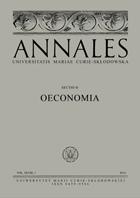The Relationship Between Private and Public Investment
in Developing Countries with Different Levels of Human Capital
The Relationship Between Private and Public Investment
in Developing Countries with Different Levels of Human Capital
Author(s): Michał BrzozowskiSubject(s): National Economy, Public Finances, Human Resources in Economy
Published by: Wydawnictwo Naukowe Uniwersytetu Marii Curie-Sklodowskiej
Keywords: private investment; public investment; human development;
Summary/Abstract: Theoretical background: Public capital goods can directly boost the productivity of private capital equip- ment, thus, increasing the profitability of private investment. In addition, in developing countries, public capital has an indirect effect on the rate of return on private capital because it facilitates the accumulation of human capital. Through these channels, the negative consequences of an increase in interest rates associ- ated with fiscal expansion can be offset, and the crowding-out effect of public investment can be reversed. Purpose of the article: The aim of this paper is to reassess the extent to which public investment crowds in or crowds out private fixed capital expenditure in developing economies. Research methods: Panel data on 89 developing countries from the period 1970–2015 and several esti- mation methods are used. Care of the endogeneity problem was taken, slope heterogeneity assumption was relaxed and several measures of educational attainment were used. Main findings: The crowding-in phenomenon is found to be stronger in countries with low levels of education and health. It seems that the positive productivity-enhancing effect of public investment on private investment is partially offset by the decrease in the income share of physical capital in countries that witness improvements in human capital. Public capital accumulation in countries which have achieved high human development is less effective, meaning that public investment should precede non-investment spending on education and health.
Journal: Annales Universitatis Mariae Curie-Skłodowska, Sectio H Oeconomia
- Issue Year: LVII/2023
- Issue No: 3
- Page Range: 7-31
- Page Count: 25
- Language: English

